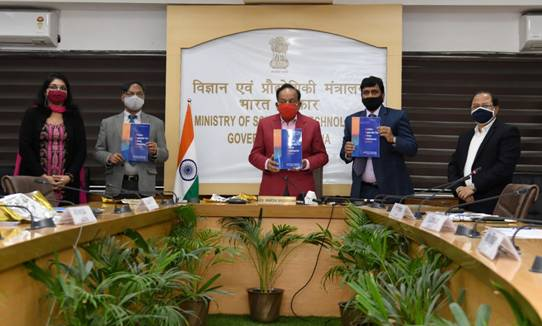Dr Harsh Vardhan releases the report Action Agenda for an AtmaNirbhar Bharat(AAAN) prepared by TIFAC in New Delhi today
New Delhi: The Minister of Science& Technology, Earth Sciences and Health & Family Welfare Dr HarshVardhan released the report Action Agenda for an AtmaNirbhar Bharat(AAAN) prepared byTechnology Information, Forecasting and Assessment Council (TIFAC) in New Delhi today. Secretary, DST, Prof Ashutosh Sharma; ED, TIFAC Prof Pradeep Srivastava and other senior scientists from TIFAC were present on the occasion.
The comprehensive report AAAN is a consequential follow-up of the TIFAC’s White Paper on Focused Interventions for ‘Make in India’: post COVID -19 which was released earlier in July, 2020 by Dr Harsh Vardhan.The White Paper highlighted five thrust sectors namely, Healthcare, Machinery, ICT, Agriculture, Manufacturing, and Electronics that would be critical for India’s economic growth post-COVID using technology stimulus and captured sector-specific strengths, market trends and opportunities.
Addressing at the event, Dr Harsh Vardhan said that the vision of the Prime Minister, Shri Narendra Modi has stood by us during the Covid pandemic. It is this which has given confidence to the people of the country, “ We have been able to beat the virus, we have even left behind the professional acumen of the world”. “ We have shown to the world ‘When India decides, it does’” , the Minister stated.
Appreciating the diligent efforts of TIFAC, Dr Harsh Vardhan said that the ideas contained in the AAAN report should be taken forward with the implementing agencies. “The ultimate outcome of the report has to be addition to quality of life and how our efforts can contribute to Atmanirbhar Bharat” , the Minister explained.
Elaborating the need for relentless efforts, “Implementing the action agenda requires a lot of efforts, perseverance and pursuance and we should not be found wanting in this area”. A roadmap should be drawn for implementing the key suggestions in the AAAN report by 15th August, 2022 when India turns 75 years old, Dr Harsh Vardhan advised.
Secretary, DST said that the aim of the Action Report is to create a sense of Scientific Social Responsibility and to lay down imperatives for future of technology in India. It looks at the challenges, possibilities and how to find solutions, he said.
Prof Pradeep Srivastava made a detailed presentation on the AAAN report.
Action Agenda for an AtmaNirbhar Bharat(AAAN)-Backgorund
The ongoing pandemic, Covid 19 onslaught, has torn the world apart. The World today is experiencing an unprecedented health and economic crisis. A widespread deep global recession has been bolstered, undermining global cooperation and multilateralism. The most outward global economies have turned inwards and are designing enhanced measures for rebooting and resilience of the economy.
TIFAC’s White Paper on Focused Interventions for ‘Make in India’: post COVID -19 which was released in July, 2020, has highlighted five thrust sectors namely, Healthcare, Machinery, ICT, Agriculture, Manufacturing, and Electronics that would be critical for India’s economic growth using technology stimulus and captured sector-specific strengths, market trends and opportunities.
Post-release of the White Paper, as a consequential follow-up, and in order to maximize the impact of the White paper on economic resilience, TIFAC followed a consultative approach and organised a series of brainstorming workshops involving key players of each sector covering Industry, Academia, R&D Institutes and Policy makers. The detailed deliberations and specific recommendations have been presented in this comprehensive report titled “AAAN” as an Action Agenda for an AtmaNirbhar Bharat.
This comprehensive action plan(AAAN) has been structured with reference to timeline, highlighting short/medium and long term interventions in various identified sectors. The document also specifically defines overarching policy recommendations with reference to technological inputs, focusing towards Local to Global thereby reviving Indian economy, in identified domains of Innovation and Technology development, Technology Adoption/Diffusion, Boosting up Manufacturing and Productivity, Trade and Globalization, Internet Policy and Data Management & Education and Training, AI among others.

